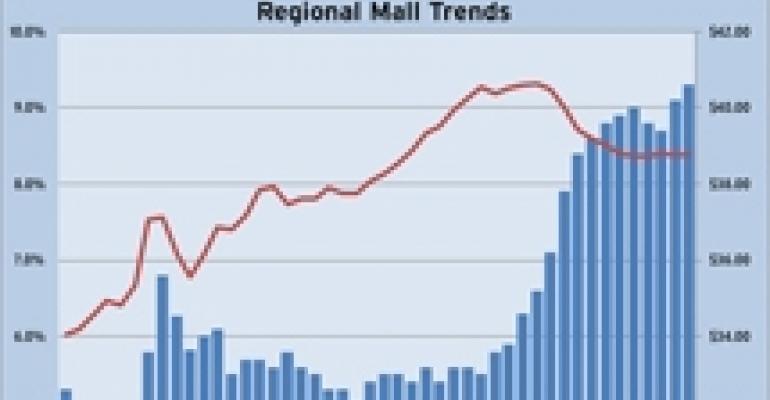Vacancy rates at shopping centers and regional malls both jumped again in the second quarter, according to real estate research firm Reis Inc.’s latest report.
The vacancy rate at malls jumped to 9.3 percent—the highest level since Reis began tracking the sector in 2000. At shopping centers, meanwhile, the rate rose to 11.0 percent after remaining stable at 10.9 percent during the four previous quarters. The vacancy rate is not just 10 basis points away from the all-time peak of 11.1 percent that Reis measured in 1990.

The figures were part of Reis’ second quarter first glance report and stand in contrast with CoStar’s first look report, which came out two weeks ago. CoStar said that the retail real estate market has now experienced eight straight quarters of positive net absorption resulting in a cumulative 99 million square feet absorption. It measured the overall retail vacancy rate as remaining stable at 7.1 percent.
In the company’s monthly commentary Reis Senior Economist Ryan Severino described the factors that contributed to the dismal vacancy numbers. According to the firm, net absorption turned negative for the first time since the second quarter of 2010. And the increase in the vacancy rate could have been worse if not for the low number of new retail completions. According to Reis, just 638,000 square feet of new neighborhood and community center space came online during the period, the second-lowest level of new deliveries for any quarter since Reis began publishing quarterly data in 1999.
According to the firm’s write-up, “The sector continues to struggle from the overhang of too much existing inventory and a dramatic pullback in demand since the economy entered the recession. Unlike office and apartment, which are already recovering, the lack of both demand and supply for new space is emblematic of a property sector that is still suffering two years after the technical end of the recession.”
As for rents, the firm said asking rents at neighborhood and community centers fell 6 cents from the previous quarter to $18.97 per square foot. Asking rents peaked at $19.65 per square foot in the second quarter of 2008. Effective rents, meanwhile, were down one cent to $16.54 per square foot and are down 6.2 percent from a peak of $17.64 per square foot in the first quarter of 2008. Regional mall rents, meanwhile, rose 2 cents from the previous quarter to $38.77 per square foot. Rents are down 4.6 percent from a peak of $40.62 in the third quarter of 2008.

The vacancy rate for neighborhood and community centers remained flat or increased in 40 of the primary 80 metropolitan areas; effective rents remained flat or declined in 46 out of 80 markets.
According to Reis, “These trends reflect slightly more widespread weakness than last quarter, and augur for a continued bumpy road ahead for retail properties.”
According to Reis, “The ongoing lack of demand for retail goods and retail space has not left regional malls unscathed, with tenants considering other retail formats or scaling back on their space requirements. Furthermore, this segment of the market continues to contend with the fallout of properties which lost an anchor tenant in 2009 or 2010.”
Going forward, Reis expects the retail sector to remain challenged due to a darkening macroeconomic picture as well as continued challenges within the industry. “Even if demand for space somehow begins to rise, low occupancy rates at retail properties imply that it will take a while before space leases up and vacancies tighten enough for landlords to begin feeling confident about raising rents and taking away concessions,” Reis wrote. “Expect continued difficulties for the retail sector in the latter half of 2011. With demand remaining so weak and new completions anticipated to increase in the latter of half of 2011, we expect the vacancy rate for neighborhood and community centers to break the 11.1% record high observed in 1990 sometime later this year. Moreover, the ongoing problems at regional malls with vacant anchor space hints that we could also continue to see new record high vacancy rates for this segment of the retail market later this year.”

